Surface Topography of Si/TiO2 Stacked Layers on Silicon Substrate Deposited by KrF Excimer Laser Ablation
Abstract
:1. Introduction
2. Materials and Methods
2.1. Pulsed Laser Deposition and Materials
2.2. Characterization Techniques and Methods
3. Results and Discussion
3.1. Deposition of the Stacked Si/TiO2 Thin Films on (100) Si Wafer
3.2. AFM Characterization of TiO2 and Si Deposited Thin Films on (100) Si Wafer
The Roughness Versus the Length-Scale Related to the Target-Substrate Distance
3.3. Structural and Optical Characterization of TiO2 Thin Films
3.3.1. X-ray Diffraction and X-ray Reflectivity
3.3.2. Ellipsometry
4. Conclusions
Author Contributions
Funding
Institutional Review Board Statement
Informed Consent Statement
Data Availability Statement
Conflicts of Interest
References
- Leray, J.-L. Chapter 2: A review of buried oxide structures and SOI technologies. In Instabilities in Silicon Devices; Barbotin, G., Vapaille, A., Eds.; Elsevier: Amsterdam, The Netherlands, 1999; Volume 3, pp. 145–231. [Google Scholar]
- Maserjian, J. Single-crystal germanium films by micro-zone melting. Solid-State Electron. 1963, 6, 477–480. [Google Scholar] [CrossRef]
- Jastrzebski, L.; Corboy, J.F.; McGinn, J.T.; Pagliaro, R. Growth process of silicon over SiO2 by CVD: Epitaxial lateral overgrowth technique. J. Electrochem. Soc. 1983, 130, 1571–1580. [Google Scholar] [CrossRef]
- Izumi, K.; Doken, M.; Ariyoshi, H. C.M.O.S. devices fabricated on buried SiO2 layers formed by oxygen implantation into silicon. Electron. Lett. 1978, 14, 593–594. [Google Scholar] [CrossRef]
- Maszara, W.P.; Goetz, G.; Caviglia, A.; McKitterick, J.B. Bonding of silicon wafers for silicon-on-insulator. J. Appl. Phys. 1988, 64, 4943–4950. [Google Scholar] [CrossRef]
- Gosele, U.; Reiche, M.; Tong, Q.Y. Properties of SIMOX and bonded SOI material. Microelectron. Eng. 1995, 28, 391–397. [Google Scholar] [CrossRef]
- Bruel, M. Silicon on insulator material technology. Electron. Lett. 1995, 31, 1201–1202. [Google Scholar] [CrossRef]
- Aspar, B.; Bruel, M.; Moriceau, H.; Maleville, C.; Poumeyrol, T.; Papon, A.M.; Claverie, A.; Benassayag, G.; Auberton-Hervé, A.J.; Barge, T. Basic mechanisms involved in the Smart-Cut® process. Microelectron. Eng. 1997, 36, 233–240. [Google Scholar] [CrossRef]
- Moise, C.; Brincoveanu, O.; Katona, A.; Dorobantu, D.; Bojin, D.; Enachescu, M. The study of p-Si/Al2O3/n-Si (100) sandwiches structures deposited by KrF excimer laser ablation. In Proceedings of the 40th-ARA Congress, Montreal, QC, Canada, 28–31 July 2016; Vidu, R., Mindicanu, A., Eds.; ARA Publisher: Montreal, QC, Canada, 2016. [Google Scholar]
- Clude, P. (Ed.) Laser Ablation and Its Applications, 1st ed.; Springer: Boston, MA, USA, 2007. [Google Scholar]
- Stafe, M.; Marcu, A.; Puscas, N. Pulsed Laser Ablation of Solids–Basics, Theory and Applications, 1st ed.; Springer: Berlin/Heidelberg, Germany, 2014. [Google Scholar]
- Linnik, O.; Chorna, N.; Smirnova, N.; Eremenko, A.; Korduban, O.; Stefan, N.; Ristoscu, C.; Socol, G.; Miroiu, M.; Mihailescu, I.N. Pulsed Laser-Deposited TiO2-based Films: Synthesis, Electronic Structure and Photocatalytic Activity. In Semiconductor Photocatalysis–Materials, Mechanisms and Applications, 1st ed.; Cao, W., Ed.; IntechOpen: London, UK, 2016; Volume 1, pp. 135–161. [Google Scholar]
- Niilisk, A.; Moppel, M.; Pärs, M.; Sildos, I.; Jantson, T.; Avarmaa, T.; Jaaniso, R.; Aarik, J. Structural study of TiO2 thin films by micro-Raman spectroscopy. Centr. Eur. J. Phys. 2006, 4, 105–116. [Google Scholar] [CrossRef] [Green Version]
- Wang, Z.; Helmersson, U.; Käll, P.O. Optical properties of anatase TiO2 thin films prepared by aqueous sol–gel process at low temperature. Thin Solid Film. 2002, 405, 50–54. [Google Scholar] [CrossRef]
- Sen, S.; Mahanty, S.; Roy, S.; Heintz, O.; Bourgeois, S.; Chaumont, D. Investigation on sol–gel synthesized Ag-doped TiO2 cermet thin films. Thin Solid Film. 2005, 474, 245–249. [Google Scholar] [CrossRef]
- Gyanan, M.S.; Kumar, A. Tunable dielectric properties of TiO2 thin film based MOS systems for application in microelectronics’. Superlattices Microstruct. 2016, 100, 876–885. [Google Scholar] [CrossRef]
- Mech, B.C.; Kumar, J. Effect of high-k dielectric on the performance of Si, InAs and CNT FET. Micro Nano Lett. 2017, 12, 624–629. [Google Scholar] [CrossRef]
- Moudgil, A.; Singh, S.; Mishra, N.; Mishra, P.; Das, S. MoS2/TiO2 Hybrid Nanostructure-Based Field-Effect Transistor for Highly Sensitive, Selective, and Rapid Detection of Gram-Positive Bacteria. Adv. Mater. Technol. 2020, 5, 1900615. [Google Scholar] [CrossRef]
- Ahn, J.-H.; Choi, B.; Choi, S.-J. Understanding the signal amplification in dual-gate FET-based biosensors. J. Appl. Phys. 2020, 128, 184502. [Google Scholar] [CrossRef]
- Tang, X.; Bayot, V.; Reckinger, N.; Flandre, D.; Raskin, J.-P.; Dubois, E.; Nysten, B. A Simple Method for Measuring Si-Fin Sidewall Roughness by AFM. IEEE Trans. Nanotechnol. 2009, 8, 611–616. [Google Scholar] [CrossRef]
- Abreu Fernandes, S.; Schöps, B.; Nett, R.; Dobbelstein, H.; Stümmler, D.; Ostendorf, A. Laser Ablation of a Thin Film Multilayer for Organic Solar Cells. In Proceedings of the 28th European Photovoltaic Solar Energy Conference and Exhibition (28th EUPVSEC), Paris, France, 30 September–4 October 2013; pp. 2789–2792. [Google Scholar]
- Hendel, R. Laser Applications in Solar Cell Manufacturing. Laser Tech. J. 2008, 5, 32–35. [Google Scholar] [CrossRef]
- Ulmeanu, M.; Serghei, A.; Mihailescu, I.N.; Budau, P.; Enachescu, M. C–Ni amorphous multilayers studied by atomic force microscopy. Appl. Surf. Sci. 2000, 165, 109–115. [Google Scholar] [CrossRef]
- Stover, J.C. Optical Scattering: Measurement and Analysis, 3rd ed.; PM224; SPIE The International Society for Optical Engineering: Bellingham, WA, USA, 2012. [Google Scholar]
- Nečas, D.; Klapetek, P. One-dimensional autocorrelation and power spectrum density functions of irregular regions. Ultramicroscopy 2013, 124, 13–19. [Google Scholar] [CrossRef]
- Pedreira de Freitas, A.C.; Cardoso Espejo, L.; Brossi Botta, S.; de Sa Teixeira, F.; Aparecida, M.; Cerqueira Luz, A.; Garone-Netto, N.; Bona Matos, A.; Barbosa da Silveira Salvadoril, M.C. AFM analysis of bleaching effect on dental enamel microtopography. Appl. Surf. Sci. 2010, 256, 2915–2919. [Google Scholar] [CrossRef]
- Acosta-Alba, P.; Gourdel, C.; Kononchuk, O. Smoothening by Self-Diffusion of Silicon during Annealing in a Rapid Processing Chamber. Solid State Phenom. 2014, 205-206, 364–369. [Google Scholar] [CrossRef]
- Singh, R.K.; Holland, O.W.; Narayan, J. Theoretical model for deposition of superconducting thin films using pulsed laser evaporation technique. J. Appl. Phys. 1990, 68, 233. [Google Scholar] [CrossRef]
- Berni, M.; Bontempi, M.; Marchiori, G.; Gambardella, A. Roughness conformality during thin films deposition onto rough substrate: A quantitative study. Thin Solid Film. 2020, 709, 138258. [Google Scholar] [CrossRef]
- Pelliccione, M.; Lu, T.M. Evolution of Thin Film Morphology–Modeling and Simulations, 1st ed.; Springer: New York, NY, USA, 2008. [Google Scholar]
- Moret, M.P.; Zallen, R.; Vijay, D.P.; Desu, S.B. Brookite-rich titania films made by pulsed laser deposition. Thin Solid Film. 2000, 366, 8–10. [Google Scholar] [CrossRef]
- Dam, T.; Jena, S.S.; Pradhan, D.K. Equilibrium state of anatase to rutile transformation for nano-structured Titanium Dioxide powder using polymer template method. In Proceedings of the IOP Conference Series: Materials Science and Engineering 5th National Conference on Processing and Characterization of Materials, Rourkela, India, 12–13 December 2015. [Google Scholar]
- Coronado, D.R.; Gattorno, G.R.; Pesqueira, M.E.E.; Cab, C.; de Coss, R.; Oskam, G. Phase-pure TiO2 nanoparticles: Anatase, brookite and rutile. Nanotechnology 2008, 19, 145605. [Google Scholar] [CrossRef] [PubMed]
- Zhao, B.; Chen, F.; Huanga, Q.; Zhanga, J. Brookite TiO2 nanoflowers. Chem. Commun. 2009, 34, 5115–5117. [Google Scholar] [CrossRef]
- Nechache, R.; Nicklaus, M.; Diffalah, N.; Ruediger, A.; Rosei, F. Pulsed laser deposition growth of rutile TiO2 nanowires on Silicon substrates. Appl. Surf. Sci. 2014, 313, 4852. [Google Scholar] [CrossRef]
- Bokhimi, X.; Pedraza, F. Characterization of brookite and a new corundum-like titania phase synthesized under hydrothermal conditions. J. Solid State Chem. 2004, 177, 2456–2463. [Google Scholar] [CrossRef]
- Zhao, Q.; Xu, J.; Xu, X.Y.; Wang, Z.; Yua, D.P. Field emission from AlN nanoneedle arrays. Appl. Phys. Lett. 2004, 85, 5331. [Google Scholar] [CrossRef]
- Hullavarad, S.; Hullavarad, N.; Look, D.; Claflin, B. Persistent Photoconductivity Studies in Nanostructured ZnO UV Sensors. Nanoscale Res. Lett. 2009, 4, 1421. [Google Scholar] [CrossRef] [PubMed] [Green Version]
- ICDD. PDF-4 Database, International Centre for Diffraction Data; ICDD: Newtown Square, PA, USA, 2018. [Google Scholar]
- Qaid, S.M.H.; Hussain, M.; Hezam, M.; Khan, M.A.M.; Albrithen, H.; Ghaithan, H.M.; Aldwayyan, A.S. Structural and optical investigation of brookite TiO2 thin films grown by atomic layer deposition on Si (111) substrates. Mater. Chem. Phys. 2019, 225, 55–59. [Google Scholar] [CrossRef]
- Haggerty, J.E.S.; Schelhas, L.T.; Kitchaev, D.A.; Mangum, J.S.; Garten, L.M.; Sun, W.; Stone, K.H.; Perkins, J.D.; Toney, M.F.; Ceder, G.; et al. High-fraction brookite flms from amorphous precursors. Nat. Sci. Rep. 2017, 7, 15232. [Google Scholar] [CrossRef] [PubMed]
- Su, H.-C.; Lee, C.-H.; Lin, M.-Z.; Huang, T.-W. A Comparison Between X-ray Reflectivity and Atomic Force Microscopy on the Characterization of a Surface Roughness. Chin. J. Phys. 2012, 50, 291–300. [Google Scholar]
- McDaniel, M.D.; Posadas, A.; Wang, T.; Demkov, A.A.; Ekerdt, J.G. Growth and characterization of epitaxial anatase TiO2(001) on SrTiO3-buffered Si (001) using atomic layer deposition. Thin Solid Film. 2012, 520, 6525–6530. [Google Scholar] [CrossRef]
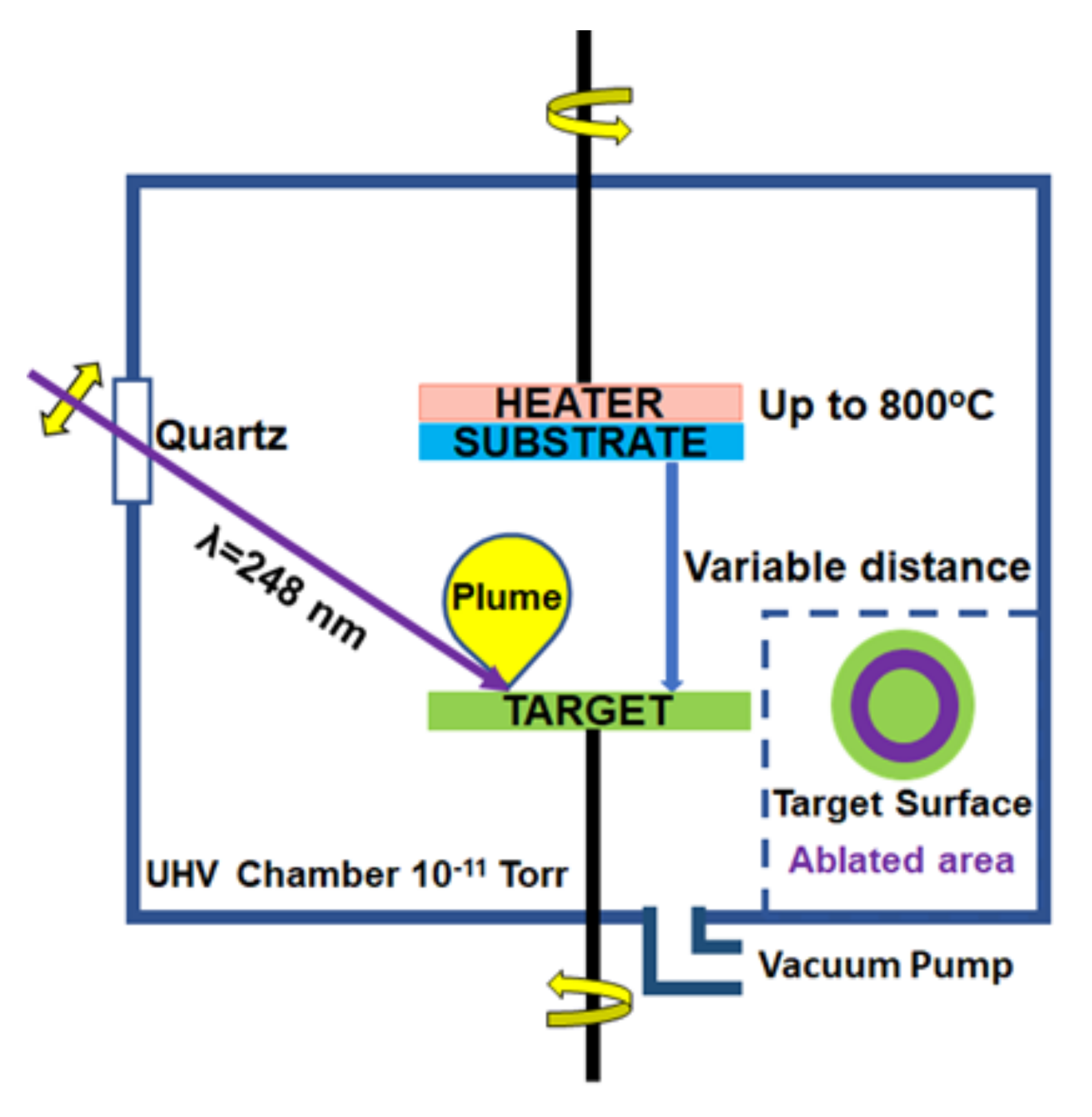
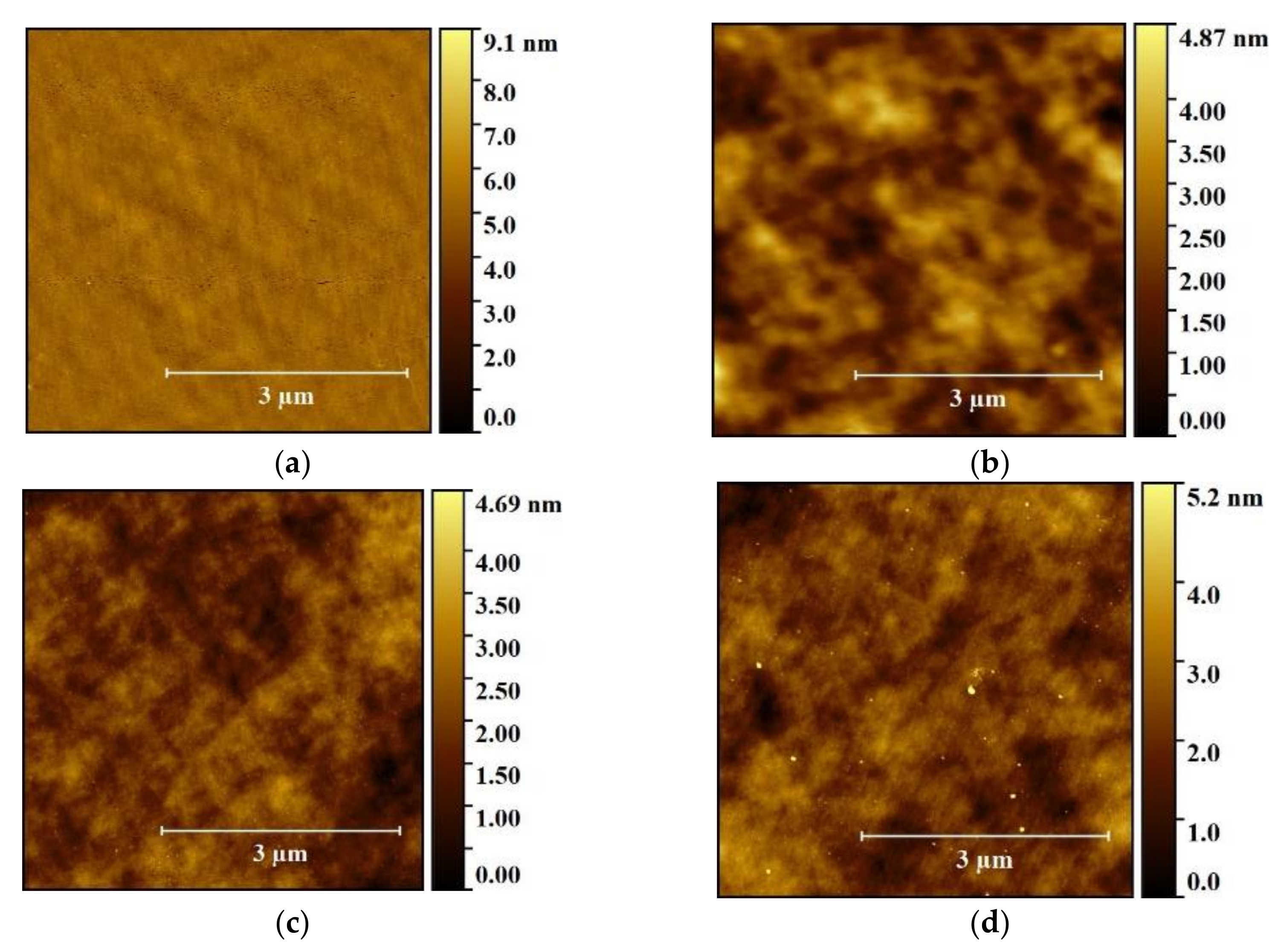

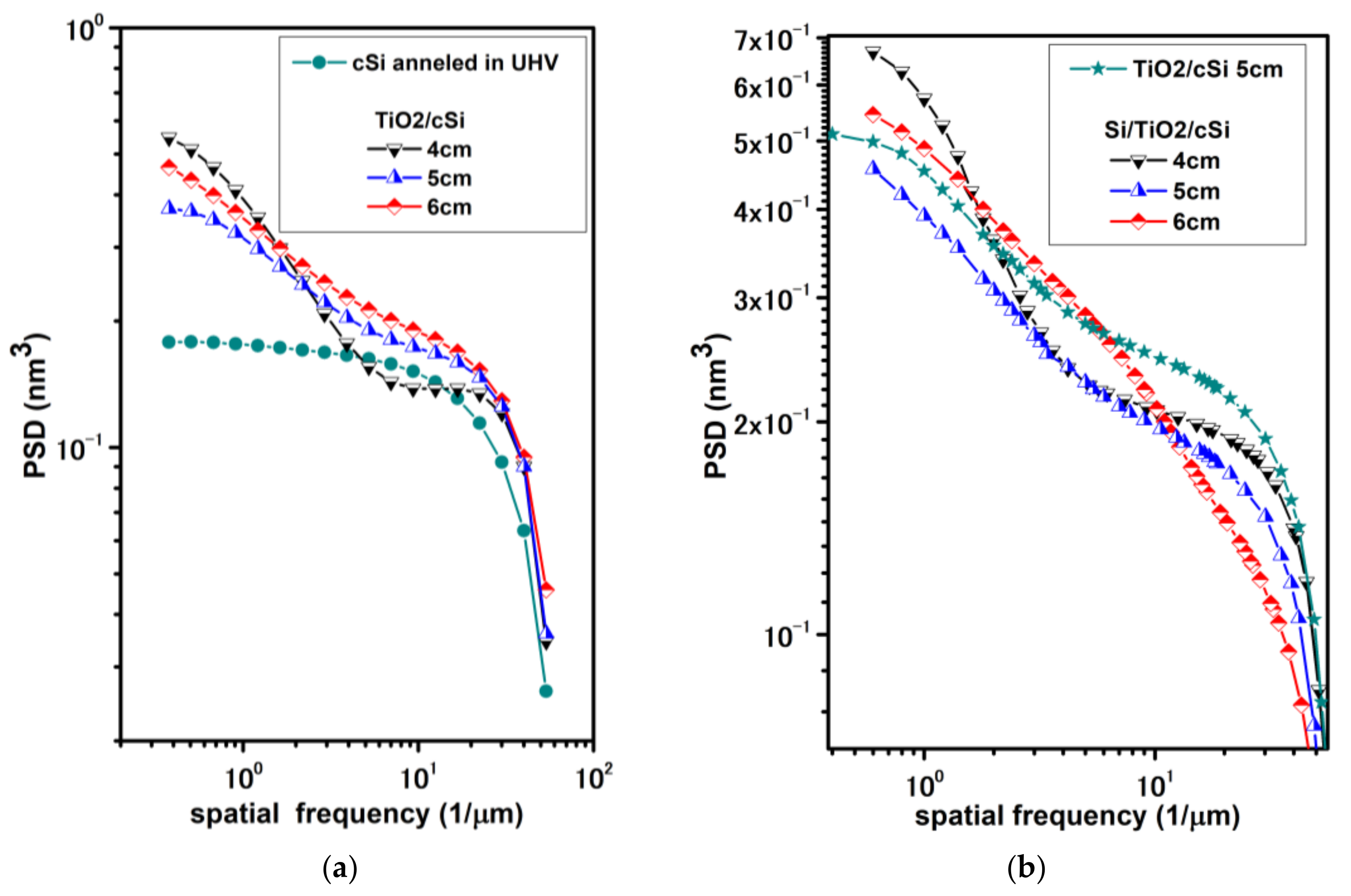
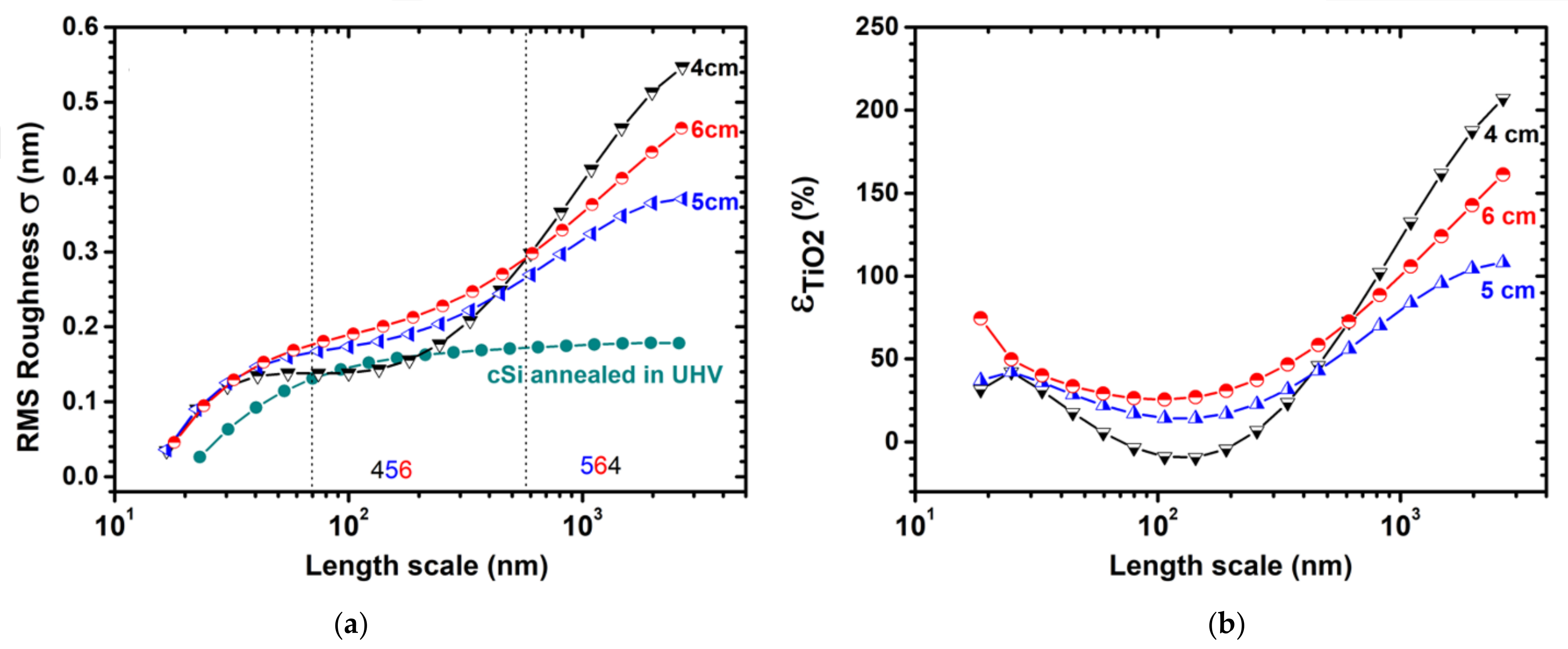
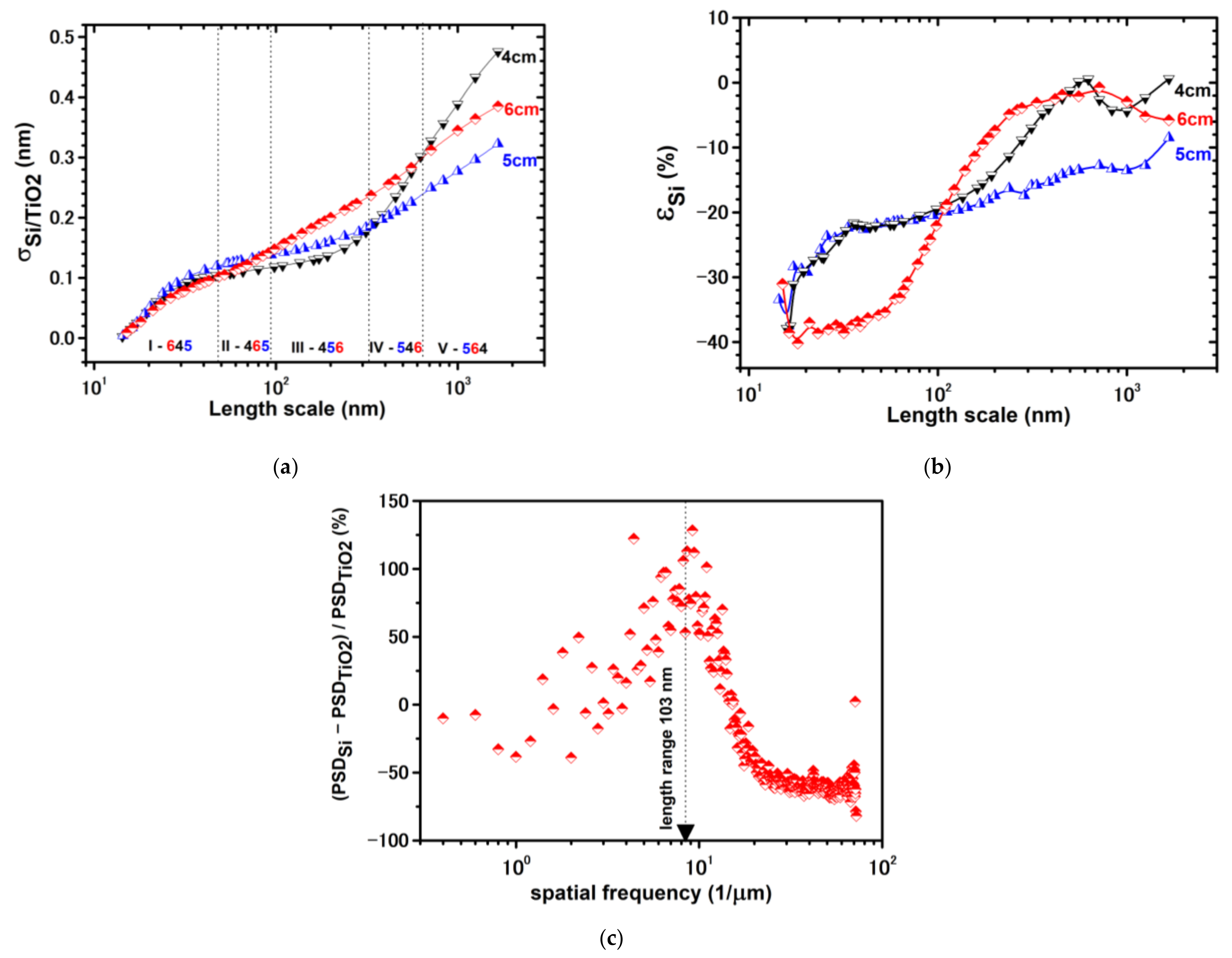


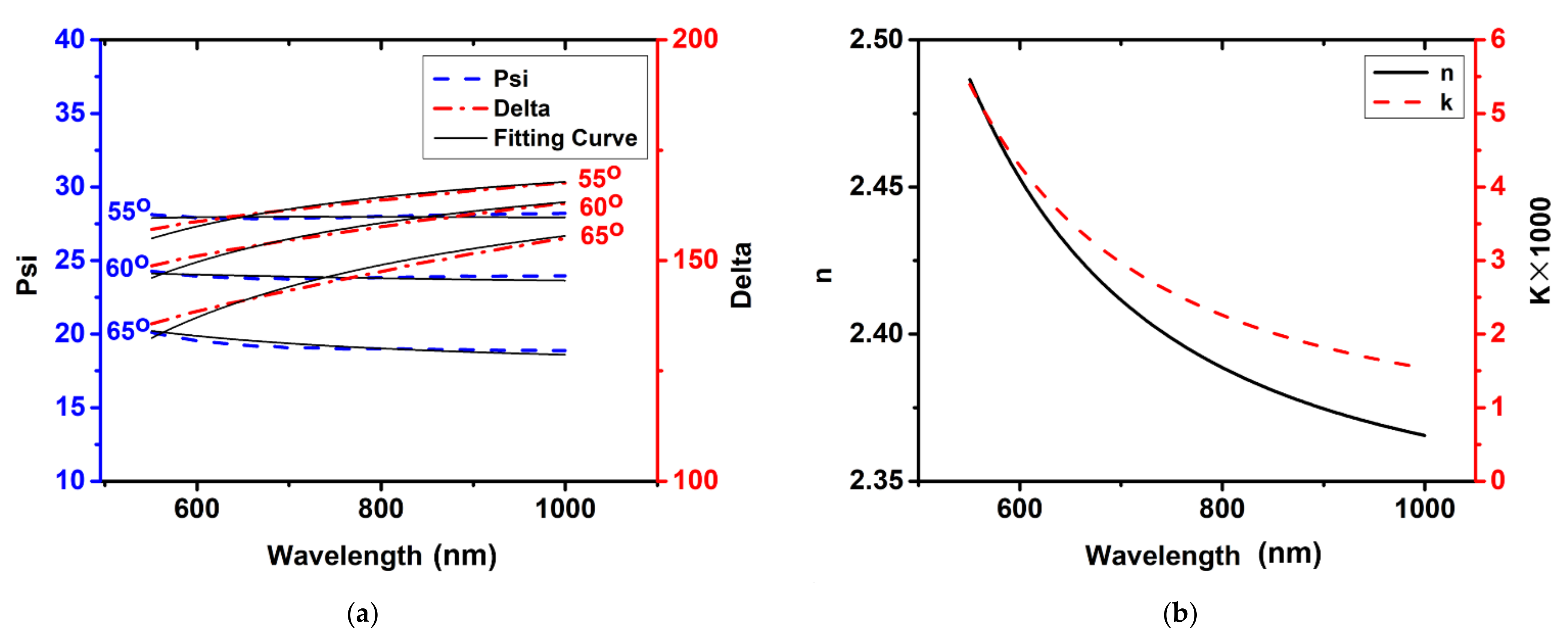
| Deposition Parameters | AFM Analysis | ||||||||
|---|---|---|---|---|---|---|---|---|---|
| Sample | Deposited Thin Film | dTS (cm) | T (°C) | E (mJ) | RR (Hz) | Pi (Torr) | Pa (Torr) | σRMS (nm) | σa (nm) |
| S0 | Si wafer | x | x | x | x | x | x | 0.21 ± 0.026 | 0.19 ± 0.023 |
| S1 | TiO2 | 4 | 500 | 500 | 30 | 6.7 × 10−9 | 4.2 × 10−7 | 0.58 ± 0.098 | 0.46 ± 0.083 |
| Si | 4 | 500 | 500 | 30 | 7.6 × 10−9 | 0.9 × 10−7 | 0.58 ± 0.077 | 0.44 ± 0.040 | |
| S2 | TiO2 | 5 | 500 | 500 | 30 | 5.8 × 10−9 | 4.8 × 10−7 | 0.37 ± 0.063 | 0.29 ± 0.048 |
| Si | 5 | 500 | 500 | 30 | 3.9 × 10−9 | 1.0 × 10−7 | 0.36 ± 0.024 | 0.29 ± 0.018 | |
| S3 | TiO2 | 6 | 500 | 500 | 30 | 6.0 × 10−9 | 4.2 × 10−7 | 0.46 ± 0.024 | 0.35 ± 0.023 |
| Si | 6 | 500 | 500 | 30 | 2.2 × 10−9 | 5.0 × 10−8 | 0.48 ± 0.090 | 0.32 ± 0.058 | |
Publisher’s Note: MDPI stays neutral with regard to jurisdictional claims in published maps and institutional affiliations. |
© 2021 by the authors. Licensee MDPI, Basel, Switzerland. This article is an open access article distributed under the terms and conditions of the Creative Commons Attribution (CC BY) license (https://creativecommons.org/licenses/by/4.0/).
Share and Cite
Moise, C.C.; Pantazi, A.; Mihai, G.V.; Jderu, A.; Bercu, M.; Messina, A.A.; Enăchescu, M. Surface Topography of Si/TiO2 Stacked Layers on Silicon Substrate Deposited by KrF Excimer Laser Ablation. Coatings 2021, 11, 1350. https://doi.org/10.3390/coatings11111350
Moise CC, Pantazi A, Mihai GV, Jderu A, Bercu M, Messina AA, Enăchescu M. Surface Topography of Si/TiO2 Stacked Layers on Silicon Substrate Deposited by KrF Excimer Laser Ablation. Coatings. 2021; 11(11):1350. https://doi.org/10.3390/coatings11111350
Chicago/Turabian StyleMoise, Călin Constantin, Aida Pantazi, Geanina Valentina Mihai, Alin Jderu, Mircea Bercu, Angelo Alberto Messina, and Marius Enăchescu. 2021. "Surface Topography of Si/TiO2 Stacked Layers on Silicon Substrate Deposited by KrF Excimer Laser Ablation" Coatings 11, no. 11: 1350. https://doi.org/10.3390/coatings11111350
APA StyleMoise, C. C., Pantazi, A., Mihai, G. V., Jderu, A., Bercu, M., Messina, A. A., & Enăchescu, M. (2021). Surface Topography of Si/TiO2 Stacked Layers on Silicon Substrate Deposited by KrF Excimer Laser Ablation. Coatings, 11(11), 1350. https://doi.org/10.3390/coatings11111350







